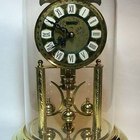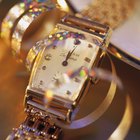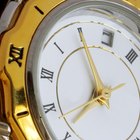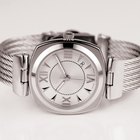
Quartz clocks are analog or digital clocks that use an electronic oscillator regulated by a quartz crystal to measure time. Quartz is silicon dioxide, which is a crystalline mineral found in sand and the earth's crust. Quartz watches run on a thin slice of man-made quartz that vibrates in response to electric charges, which allows the watch to keep time. Switzerland and Japan have been the vanguards of the quartz watch movements since the mid 20th century. Yet, the Swiss and the Japanese have been in a perpetual rivalry to be the world's top quartz manufacturer.
History of Swiss Quartz
During World War II, Switzerland had a monopoly on consumer watches while other countries shifted their watchmaking to make clocks for military devices. When quartz watches were introduced in the early 1950s, quartz watch production exploded. Yet, the Swiss resisted change because they did not want to change their old ways of traditional Swiss skill and manufacturing. Therefore, in the 1970s, the Swiss watch industry plunged into a depression, called the "Quartz Crisis." Although the Swiss introduced their first quartz watch in 1971, the Ebauches SA Beta 21, Swiss quartz did not gain popularity until 1983, when they introduced their sleek version of the quartz watch, the "Swatch."
History of Japanese Quartz
While the Swiss were mired in the Quartz crisis, the Japanese were enjoying the "Quartz Revolution." Although the Swiss began developing quartz watches in the 1960s, Seiko, Japan's premier watch manufacturing company, beat the Swiss with the introduction of a portable quartz clock, the Seiko Crystal Chronometer QC-951. On Christmas Day in 1969, the Japanese then unveiled the first commercial quartz watch, the Astron. Throughout the 1970s, Japan was the world's largest exporter of electronic quartz watches.
Swiss Quartz Watches
Swiss quartz watches must be genuinely constructed with fine Swiss materials to have the title of a Swiss quartz watch. The Federation of the Swiss Watch Industry has a list of "Verordnung Swiss Made" rules: a quartz watch is only Swiss if it has a Swiss movement that was made by a Swiss manufacturer, and was set into its case in Switzerland. (A watch's movement is the mechanism that correctly keeps track of the time.) Although the Japanese were the first to release quartz on the market, Swiss watches are generally more expensive because Swiss movements are regarded as being of a better quality. Swiss quartz is known to be reliable, accurate, and water and shock resistant.
Japanese Quartz Watches
Japan's primary quartz watch manufacturer, Seiko, has produced small, more reasonably priced quartz watches since the 1960s. Japan eliminated the bulky watch case and short-lived battery life by reducing the volume of the watch case and reducing its power consumption. Japanese quartz is also shock and water resistant, and some have automatic alarms. Japanese quartz is known for accuracy, and was used as the official timekeeper at many Olympic games. Although both Swiss and Japanese quartz watches are functional, quality watches, the Swiss are currently the largest exporter of quartz watches.
Related Articles

How to Evaluate Invicta Watches

Pulsar Chronograph Watch Instructions

Marc Ecko Watch Instructions

What Is an Anniversary Clock?

How to Tell if a Waltham Watch is ...

How to Adjust a Movado Watch

How to Fix a Stalled Second Hand on a ...

How to Set an Elgin Watch

The Advantages of a Wind Up Watch

Sector Watch Instructions

The History of Geneve Watches

How to Set the Date and Time on a Rolex ...

Tag Heuer Aquaracer Alarm Instructions

How to Set the Time on a Rolex Daytona

How to Set a Rolex Day-Date

Instructions for How to Set a Stauer ...

Stauer Hybrid Watch Instructions

How to Remove a Stuhrling Watch Band

How to Set a Festina Watch

Swiss Military Watch Instructions
References
Photo Credits
Getty Images/Getty Images News/Getty Images